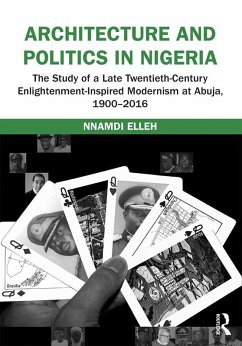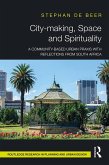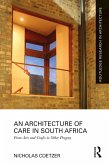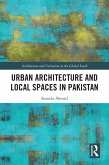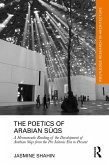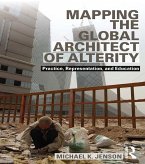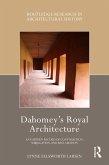Nnamdi Elleh
Architecture and Politics in Nigeria (eBook, PDF)
The Study of a Late Twentieth-Century Enlightenment-Inspired Modernism at Abuja, 1900-2016
41,95 €
41,95 €
inkl. MwSt.
Sofort per Download lieferbar

21 °P sammeln
41,95 €
Als Download kaufen

41,95 €
inkl. MwSt.
Sofort per Download lieferbar

21 °P sammeln
Jetzt verschenken
Alle Infos zum eBook verschenken
41,95 €
inkl. MwSt.
Sofort per Download lieferbar
Alle Infos zum eBook verschenken

21 °P sammeln
Nnamdi Elleh
Architecture and Politics in Nigeria (eBook, PDF)
The Study of a Late Twentieth-Century Enlightenment-Inspired Modernism at Abuja, 1900-2016
- Format: PDF
- Merkliste
- Auf die Merkliste
- Bewerten Bewerten
- Teilen
- Produkt teilen
- Produkterinnerung
- Produkterinnerung

Bitte loggen Sie sich zunächst in Ihr Kundenkonto ein oder registrieren Sie sich bei
bücher.de, um das eBook-Abo tolino select nutzen zu können.
Hier können Sie sich einloggen
Hier können Sie sich einloggen
Sie sind bereits eingeloggt. Klicken Sie auf 2. tolino select Abo, um fortzufahren.

Bitte loggen Sie sich zunächst in Ihr Kundenkonto ein oder registrieren Sie sich bei bücher.de, um das eBook-Abo tolino select nutzen zu können.
By examining the creation of the modernist national public spaces of Abuja within a broader historical and global context, this book looks at how the successes and the failures of these spaces have affected the citizens of the country.
- Geräte: PC
- mit Kopierschutz
- eBook Hilfe
- Größe: 84.67MB
Andere Kunden interessierten sich auch für
![City-making, Space and Spirituality (eBook, PDF) City-making, Space and Spirituality (eBook, PDF)]() Stéphan de BeerCity-making, Space and Spirituality (eBook, PDF)41,95 €
Stéphan de BeerCity-making, Space and Spirituality (eBook, PDF)41,95 €![An Architecture of Care in South Africa (eBook, PDF) An Architecture of Care in South Africa (eBook, PDF)]() Nicholas CoetzerAn Architecture of Care in South Africa (eBook, PDF)41,95 €
Nicholas CoetzerAn Architecture of Care in South Africa (eBook, PDF)41,95 €![Kenzo Tange and the Metabolist Movement (eBook, PDF) Kenzo Tange and the Metabolist Movement (eBook, PDF)]() Zhongjie LinKenzo Tange and the Metabolist Movement (eBook, PDF)34,95 €
Zhongjie LinKenzo Tange and the Metabolist Movement (eBook, PDF)34,95 €![Urban Architecture and Local Spaces in Pakistan (eBook, PDF) Urban Architecture and Local Spaces in Pakistan (eBook, PDF)]() Suneela AhmedUrban Architecture and Local Spaces in Pakistan (eBook, PDF)41,95 €
Suneela AhmedUrban Architecture and Local Spaces in Pakistan (eBook, PDF)41,95 €![The Poetics of Arabian Suqs (eBook, PDF) The Poetics of Arabian Suqs (eBook, PDF)]() Jasmine ShahinThe Poetics of Arabian Suqs (eBook, PDF)41,95 €
Jasmine ShahinThe Poetics of Arabian Suqs (eBook, PDF)41,95 €![Mapping the Global Architect of Alterity (eBook, PDF) Mapping the Global Architect of Alterity (eBook, PDF)]() Michael JensonMapping the Global Architect of Alterity (eBook, PDF)38,95 €
Michael JensonMapping the Global Architect of Alterity (eBook, PDF)38,95 €![Dahomey's Royal Architecture (eBook, PDF) Dahomey's Royal Architecture (eBook, PDF)]() Lynne Ellsworth LarsenDahomey's Royal Architecture (eBook, PDF)41,95 €
Lynne Ellsworth LarsenDahomey's Royal Architecture (eBook, PDF)41,95 €-
-
-
By examining the creation of the modernist national public spaces of Abuja within a broader historical and global context, this book looks at how the successes and the failures of these spaces have affected the citizens of the country.
Dieser Download kann aus rechtlichen Gründen nur mit Rechnungsadresse in A, B, BG, CY, CZ, D, DK, EW, E, FIN, F, GR, HR, H, IRL, I, LT, L, LR, M, NL, PL, P, R, S, SLO, SK ausgeliefert werden.
Produktdetails
- Produktdetails
- Verlag: Taylor & Francis eBooks
- Seitenzahl: 350
- Erscheinungstermin: 8. Dezember 2016
- Englisch
- ISBN-13: 9781317179351
- Artikelnr.: 47387065
- Verlag: Taylor & Francis eBooks
- Seitenzahl: 350
- Erscheinungstermin: 8. Dezember 2016
- Englisch
- ISBN-13: 9781317179351
- Artikelnr.: 47387065
- Herstellerkennzeichnung Die Herstellerinformationen sind derzeit nicht verfügbar.
Nnamdi Elleh, Ph.D., is Professor of Architecture at the University of Cincinnati, Ohio. His research interests include modern and contemporary architecture understood as diverse, multi-centered, regional, vernacular and localized experiences in different parts of the world.
Preface Prologue Method, Sources and the Organization of the Book 1. The
Literature 1.1. Abuja in Nigerian and African Modern Architectural History
1.2. Locating Abuja's Urban Form in Global Architectural Modernism 1.3.
Abuja as a Post-Colonial Capital City after World War II 1.4. Abuja: A
Capital City in Dis-Content with Architectural Modernism(s) 1.5. Public
Space in the Aftermath of the Iranian Revolution and in the Post-Berlin
Wall Contexts 2. The Inauguration 2.1. The Inauguration in the Civic Space,
2 December 1991 2.2. Contestations and Wars in the Public Spaces of Abuja
2.3. Emancipation in the Public Spaces at Abuja and in Nigerian Cities 2.4.
Abuja As The Public Sphere for Transforming Nigeria 3. The Amalgamation of
Nigeria and the Search for Capital City Location, 1900 - 1960 3.1 Nigeria:
A Union of Traditional and Colonial World-Views 3.2 Modern Landscapes
World-Views of Nigeria Capitalist Project 3.3 Colonial Debates to Establish
Nigeria and its National Seat of Government 3.4 Lugard and the "Dual
Mandate" World-View Plan for Nigeria 3.5. The Social Space Facilitated by
Lugard when he Established Nigeria, 1900 - 1960 3.6 Insiders' Perspective
I: Senator Abu Ibrahim and Professor Akin Mabogunje 4. Abuja: A National
Development Project or A Military Conspiracy Against Lagos? 4.1 General
Obasanjo: Making the Development of FCT Irreversible, 1976 - 1979 4.2 The
Competition and the Selection of Thomas Todd and Kenzo Tange 4.3. President
Shehu Shagari: "The Light That Failed" During The Rush to Build Abuja, 1979
to 1983 4.4 Insider's Perspectives II: Umar G. Benna 4.5 Insider's
Perspective III: E. A. D. Nsiegbe 4.6 Insider's Perspective IV: Denis
Browne 5. The Paths to "One of the Most Enormous Commercial Disputes in
History" 5.1 An Oil Boom in Patronage of "A Monument to Progress" 5.2. The
Cement Scandal: The Military Exculpates Itself from the National Congestion
Caused by Its Capitalist Interests 5.3. A Development "At Breakneck Speed":
What was at Stake for the Suppliers? 6. Thomas Todd: Reconstructing
Nigeria's Political Consciousness In Washington, D. C.'s Enlightenment
Urban Design Ideas 6.1. The City: From Sketches to Urban Spaces 6.2 The
City As a Space of Social Interactions and Mnemonics 6.3 Wallace McHarg
Roberts & Todd (WMRT) of Philadelphia 6.4 Who Designed What at Abuja? The
"American Institute of Architects (AIA) Finds Itself in the Middle of a
Design Controversy" 6.5 Siting Civic and Public Spaces in Nature at Abuja
6.6. Testing Three Generic Urban Forms on the Site: Compact,
Multi-Centered, and Linear Urban Forms 6.7. Influences of Design Concepts
from Brasília's, Chandigarh's, Canberra's, and Washington's Urban Forms on
Abuja's Urban Form 6.8. Establishing the Hygienic and Monumental Government
Precinct at Abuja 6.9. Designing Abuja's Civic and Public Spaces in the
Image of Washington, D.C.'s Urban Form 6.10. The Mall: Todd's Strategies
for Translating Abuja's National Landscapes into Civic and Public
Spaces/Spheres 6.11. Discussing Todd's Modular City: Sectors, Districts,
Communities and Neighborhoods 7. Kenzo Tange Urtec and Albert Speer
Partners 7.1. A Synopsis of the Journey from Hiroshima and Tokyo to Abuja
7.2 Reflections on the Tokyo Metropolitan Complex 7.3. Designing Abuja's
Central Area in 1981 After Tokyo Bay's 1960 Master Plan 7.4. Tange's
Fortress Three Arms Zone at Abuja 7.5. Insider's Perspective V: Ryoji
Terajima Interviewed the Interviewer 7.6. Insider's Perspective VI: Testuo
Furuichi, the Elucidator of Tange's Urban Design 7.7. Abuja' Mall: Tange's
Epitaph and Desire to Free Urban Space by Lifting Buildings on Pilotis
7.8. Albert Speer's Plan: An Ecologically-Sensitive Champs Elysees for
Abuja 7.9. Insider's Perspective VII: Matthias Nuss Examines the Master
Plans 8. Milton Keynes Development Corporation (MKDC) & Doxiadis
Associates' The Ekistics Science 8.1. Experiencing the Modern Neighborhoods
and the Neighbors 8.2 Encountering the "Other" in the Center of Unity 8.3.
Insider's Perspective VIII: John Napleton and the Design for Living
"Modern" Life at Abuja 8.4. Doxiadis Associates and the Ekistics Science
8.5 The Satellite Towns 9. Conclusion: The Planned Capital Where the
President is A "Squatter" 9.1. Giving Citizens the Opportunity to
Participate in Civic Urban and Architectural Projects 9.2. The Military's
Hidden Agenda 9.3 Capital City as the Civic and the Public Spheres for the
Exchange of Ideas 9.4. A Late Twentieth-Century Enlightenment-Inspired
African Modernism 9.5. The Planned Capital Where the President is A
"Squatter" Epilogue: The Reception "Abuja, Where Houses and People Live
Apart" A Nigerian Historical Chronology Index
Literature 1.1. Abuja in Nigerian and African Modern Architectural History
1.2. Locating Abuja's Urban Form in Global Architectural Modernism 1.3.
Abuja as a Post-Colonial Capital City after World War II 1.4. Abuja: A
Capital City in Dis-Content with Architectural Modernism(s) 1.5. Public
Space in the Aftermath of the Iranian Revolution and in the Post-Berlin
Wall Contexts 2. The Inauguration 2.1. The Inauguration in the Civic Space,
2 December 1991 2.2. Contestations and Wars in the Public Spaces of Abuja
2.3. Emancipation in the Public Spaces at Abuja and in Nigerian Cities 2.4.
Abuja As The Public Sphere for Transforming Nigeria 3. The Amalgamation of
Nigeria and the Search for Capital City Location, 1900 - 1960 3.1 Nigeria:
A Union of Traditional and Colonial World-Views 3.2 Modern Landscapes
World-Views of Nigeria Capitalist Project 3.3 Colonial Debates to Establish
Nigeria and its National Seat of Government 3.4 Lugard and the "Dual
Mandate" World-View Plan for Nigeria 3.5. The Social Space Facilitated by
Lugard when he Established Nigeria, 1900 - 1960 3.6 Insiders' Perspective
I: Senator Abu Ibrahim and Professor Akin Mabogunje 4. Abuja: A National
Development Project or A Military Conspiracy Against Lagos? 4.1 General
Obasanjo: Making the Development of FCT Irreversible, 1976 - 1979 4.2 The
Competition and the Selection of Thomas Todd and Kenzo Tange 4.3. President
Shehu Shagari: "The Light That Failed" During The Rush to Build Abuja, 1979
to 1983 4.4 Insider's Perspectives II: Umar G. Benna 4.5 Insider's
Perspective III: E. A. D. Nsiegbe 4.6 Insider's Perspective IV: Denis
Browne 5. The Paths to "One of the Most Enormous Commercial Disputes in
History" 5.1 An Oil Boom in Patronage of "A Monument to Progress" 5.2. The
Cement Scandal: The Military Exculpates Itself from the National Congestion
Caused by Its Capitalist Interests 5.3. A Development "At Breakneck Speed":
What was at Stake for the Suppliers? 6. Thomas Todd: Reconstructing
Nigeria's Political Consciousness In Washington, D. C.'s Enlightenment
Urban Design Ideas 6.1. The City: From Sketches to Urban Spaces 6.2 The
City As a Space of Social Interactions and Mnemonics 6.3 Wallace McHarg
Roberts & Todd (WMRT) of Philadelphia 6.4 Who Designed What at Abuja? The
"American Institute of Architects (AIA) Finds Itself in the Middle of a
Design Controversy" 6.5 Siting Civic and Public Spaces in Nature at Abuja
6.6. Testing Three Generic Urban Forms on the Site: Compact,
Multi-Centered, and Linear Urban Forms 6.7. Influences of Design Concepts
from Brasília's, Chandigarh's, Canberra's, and Washington's Urban Forms on
Abuja's Urban Form 6.8. Establishing the Hygienic and Monumental Government
Precinct at Abuja 6.9. Designing Abuja's Civic and Public Spaces in the
Image of Washington, D.C.'s Urban Form 6.10. The Mall: Todd's Strategies
for Translating Abuja's National Landscapes into Civic and Public
Spaces/Spheres 6.11. Discussing Todd's Modular City: Sectors, Districts,
Communities and Neighborhoods 7. Kenzo Tange Urtec and Albert Speer
Partners 7.1. A Synopsis of the Journey from Hiroshima and Tokyo to Abuja
7.2 Reflections on the Tokyo Metropolitan Complex 7.3. Designing Abuja's
Central Area in 1981 After Tokyo Bay's 1960 Master Plan 7.4. Tange's
Fortress Three Arms Zone at Abuja 7.5. Insider's Perspective V: Ryoji
Terajima Interviewed the Interviewer 7.6. Insider's Perspective VI: Testuo
Furuichi, the Elucidator of Tange's Urban Design 7.7. Abuja' Mall: Tange's
Epitaph and Desire to Free Urban Space by Lifting Buildings on Pilotis
7.8. Albert Speer's Plan: An Ecologically-Sensitive Champs Elysees for
Abuja 7.9. Insider's Perspective VII: Matthias Nuss Examines the Master
Plans 8. Milton Keynes Development Corporation (MKDC) & Doxiadis
Associates' The Ekistics Science 8.1. Experiencing the Modern Neighborhoods
and the Neighbors 8.2 Encountering the "Other" in the Center of Unity 8.3.
Insider's Perspective VIII: John Napleton and the Design for Living
"Modern" Life at Abuja 8.4. Doxiadis Associates and the Ekistics Science
8.5 The Satellite Towns 9. Conclusion: The Planned Capital Where the
President is A "Squatter" 9.1. Giving Citizens the Opportunity to
Participate in Civic Urban and Architectural Projects 9.2. The Military's
Hidden Agenda 9.3 Capital City as the Civic and the Public Spheres for the
Exchange of Ideas 9.4. A Late Twentieth-Century Enlightenment-Inspired
African Modernism 9.5. The Planned Capital Where the President is A
"Squatter" Epilogue: The Reception "Abuja, Where Houses and People Live
Apart" A Nigerian Historical Chronology Index
Preface Prologue Method, Sources and the Organization of the Book 1. The
Literature 1.1. Abuja in Nigerian and African Modern Architectural History
1.2. Locating Abuja's Urban Form in Global Architectural Modernism 1.3.
Abuja as a Post-Colonial Capital City after World War II 1.4. Abuja: A
Capital City in Dis-Content with Architectural Modernism(s) 1.5. Public
Space in the Aftermath of the Iranian Revolution and in the Post-Berlin
Wall Contexts 2. The Inauguration 2.1. The Inauguration in the Civic Space,
2 December 1991 2.2. Contestations and Wars in the Public Spaces of Abuja
2.3. Emancipation in the Public Spaces at Abuja and in Nigerian Cities 2.4.
Abuja As The Public Sphere for Transforming Nigeria 3. The Amalgamation of
Nigeria and the Search for Capital City Location, 1900 - 1960 3.1 Nigeria:
A Union of Traditional and Colonial World-Views 3.2 Modern Landscapes
World-Views of Nigeria Capitalist Project 3.3 Colonial Debates to Establish
Nigeria and its National Seat of Government 3.4 Lugard and the "Dual
Mandate" World-View Plan for Nigeria 3.5. The Social Space Facilitated by
Lugard when he Established Nigeria, 1900 - 1960 3.6 Insiders' Perspective
I: Senator Abu Ibrahim and Professor Akin Mabogunje 4. Abuja: A National
Development Project or A Military Conspiracy Against Lagos? 4.1 General
Obasanjo: Making the Development of FCT Irreversible, 1976 - 1979 4.2 The
Competition and the Selection of Thomas Todd and Kenzo Tange 4.3. President
Shehu Shagari: "The Light That Failed" During The Rush to Build Abuja, 1979
to 1983 4.4 Insider's Perspectives II: Umar G. Benna 4.5 Insider's
Perspective III: E. A. D. Nsiegbe 4.6 Insider's Perspective IV: Denis
Browne 5. The Paths to "One of the Most Enormous Commercial Disputes in
History" 5.1 An Oil Boom in Patronage of "A Monument to Progress" 5.2. The
Cement Scandal: The Military Exculpates Itself from the National Congestion
Caused by Its Capitalist Interests 5.3. A Development "At Breakneck Speed":
What was at Stake for the Suppliers? 6. Thomas Todd: Reconstructing
Nigeria's Political Consciousness In Washington, D. C.'s Enlightenment
Urban Design Ideas 6.1. The City: From Sketches to Urban Spaces 6.2 The
City As a Space of Social Interactions and Mnemonics 6.3 Wallace McHarg
Roberts & Todd (WMRT) of Philadelphia 6.4 Who Designed What at Abuja? The
"American Institute of Architects (AIA) Finds Itself in the Middle of a
Design Controversy" 6.5 Siting Civic and Public Spaces in Nature at Abuja
6.6. Testing Three Generic Urban Forms on the Site: Compact,
Multi-Centered, and Linear Urban Forms 6.7. Influences of Design Concepts
from Brasília's, Chandigarh's, Canberra's, and Washington's Urban Forms on
Abuja's Urban Form 6.8. Establishing the Hygienic and Monumental Government
Precinct at Abuja 6.9. Designing Abuja's Civic and Public Spaces in the
Image of Washington, D.C.'s Urban Form 6.10. The Mall: Todd's Strategies
for Translating Abuja's National Landscapes into Civic and Public
Spaces/Spheres 6.11. Discussing Todd's Modular City: Sectors, Districts,
Communities and Neighborhoods 7. Kenzo Tange Urtec and Albert Speer
Partners 7.1. A Synopsis of the Journey from Hiroshima and Tokyo to Abuja
7.2 Reflections on the Tokyo Metropolitan Complex 7.3. Designing Abuja's
Central Area in 1981 After Tokyo Bay's 1960 Master Plan 7.4. Tange's
Fortress Three Arms Zone at Abuja 7.5. Insider's Perspective V: Ryoji
Terajima Interviewed the Interviewer 7.6. Insider's Perspective VI: Testuo
Furuichi, the Elucidator of Tange's Urban Design 7.7. Abuja' Mall: Tange's
Epitaph and Desire to Free Urban Space by Lifting Buildings on Pilotis
7.8. Albert Speer's Plan: An Ecologically-Sensitive Champs Elysees for
Abuja 7.9. Insider's Perspective VII: Matthias Nuss Examines the Master
Plans 8. Milton Keynes Development Corporation (MKDC) & Doxiadis
Associates' The Ekistics Science 8.1. Experiencing the Modern Neighborhoods
and the Neighbors 8.2 Encountering the "Other" in the Center of Unity 8.3.
Insider's Perspective VIII: John Napleton and the Design for Living
"Modern" Life at Abuja 8.4. Doxiadis Associates and the Ekistics Science
8.5 The Satellite Towns 9. Conclusion: The Planned Capital Where the
President is A "Squatter" 9.1. Giving Citizens the Opportunity to
Participate in Civic Urban and Architectural Projects 9.2. The Military's
Hidden Agenda 9.3 Capital City as the Civic and the Public Spheres for the
Exchange of Ideas 9.4. A Late Twentieth-Century Enlightenment-Inspired
African Modernism 9.5. The Planned Capital Where the President is A
"Squatter" Epilogue: The Reception "Abuja, Where Houses and People Live
Apart" A Nigerian Historical Chronology Index
Literature 1.1. Abuja in Nigerian and African Modern Architectural History
1.2. Locating Abuja's Urban Form in Global Architectural Modernism 1.3.
Abuja as a Post-Colonial Capital City after World War II 1.4. Abuja: A
Capital City in Dis-Content with Architectural Modernism(s) 1.5. Public
Space in the Aftermath of the Iranian Revolution and in the Post-Berlin
Wall Contexts 2. The Inauguration 2.1. The Inauguration in the Civic Space,
2 December 1991 2.2. Contestations and Wars in the Public Spaces of Abuja
2.3. Emancipation in the Public Spaces at Abuja and in Nigerian Cities 2.4.
Abuja As The Public Sphere for Transforming Nigeria 3. The Amalgamation of
Nigeria and the Search for Capital City Location, 1900 - 1960 3.1 Nigeria:
A Union of Traditional and Colonial World-Views 3.2 Modern Landscapes
World-Views of Nigeria Capitalist Project 3.3 Colonial Debates to Establish
Nigeria and its National Seat of Government 3.4 Lugard and the "Dual
Mandate" World-View Plan for Nigeria 3.5. The Social Space Facilitated by
Lugard when he Established Nigeria, 1900 - 1960 3.6 Insiders' Perspective
I: Senator Abu Ibrahim and Professor Akin Mabogunje 4. Abuja: A National
Development Project or A Military Conspiracy Against Lagos? 4.1 General
Obasanjo: Making the Development of FCT Irreversible, 1976 - 1979 4.2 The
Competition and the Selection of Thomas Todd and Kenzo Tange 4.3. President
Shehu Shagari: "The Light That Failed" During The Rush to Build Abuja, 1979
to 1983 4.4 Insider's Perspectives II: Umar G. Benna 4.5 Insider's
Perspective III: E. A. D. Nsiegbe 4.6 Insider's Perspective IV: Denis
Browne 5. The Paths to "One of the Most Enormous Commercial Disputes in
History" 5.1 An Oil Boom in Patronage of "A Monument to Progress" 5.2. The
Cement Scandal: The Military Exculpates Itself from the National Congestion
Caused by Its Capitalist Interests 5.3. A Development "At Breakneck Speed":
What was at Stake for the Suppliers? 6. Thomas Todd: Reconstructing
Nigeria's Political Consciousness In Washington, D. C.'s Enlightenment
Urban Design Ideas 6.1. The City: From Sketches to Urban Spaces 6.2 The
City As a Space of Social Interactions and Mnemonics 6.3 Wallace McHarg
Roberts & Todd (WMRT) of Philadelphia 6.4 Who Designed What at Abuja? The
"American Institute of Architects (AIA) Finds Itself in the Middle of a
Design Controversy" 6.5 Siting Civic and Public Spaces in Nature at Abuja
6.6. Testing Three Generic Urban Forms on the Site: Compact,
Multi-Centered, and Linear Urban Forms 6.7. Influences of Design Concepts
from Brasília's, Chandigarh's, Canberra's, and Washington's Urban Forms on
Abuja's Urban Form 6.8. Establishing the Hygienic and Monumental Government
Precinct at Abuja 6.9. Designing Abuja's Civic and Public Spaces in the
Image of Washington, D.C.'s Urban Form 6.10. The Mall: Todd's Strategies
for Translating Abuja's National Landscapes into Civic and Public
Spaces/Spheres 6.11. Discussing Todd's Modular City: Sectors, Districts,
Communities and Neighborhoods 7. Kenzo Tange Urtec and Albert Speer
Partners 7.1. A Synopsis of the Journey from Hiroshima and Tokyo to Abuja
7.2 Reflections on the Tokyo Metropolitan Complex 7.3. Designing Abuja's
Central Area in 1981 After Tokyo Bay's 1960 Master Plan 7.4. Tange's
Fortress Three Arms Zone at Abuja 7.5. Insider's Perspective V: Ryoji
Terajima Interviewed the Interviewer 7.6. Insider's Perspective VI: Testuo
Furuichi, the Elucidator of Tange's Urban Design 7.7. Abuja' Mall: Tange's
Epitaph and Desire to Free Urban Space by Lifting Buildings on Pilotis
7.8. Albert Speer's Plan: An Ecologically-Sensitive Champs Elysees for
Abuja 7.9. Insider's Perspective VII: Matthias Nuss Examines the Master
Plans 8. Milton Keynes Development Corporation (MKDC) & Doxiadis
Associates' The Ekistics Science 8.1. Experiencing the Modern Neighborhoods
and the Neighbors 8.2 Encountering the "Other" in the Center of Unity 8.3.
Insider's Perspective VIII: John Napleton and the Design for Living
"Modern" Life at Abuja 8.4. Doxiadis Associates and the Ekistics Science
8.5 The Satellite Towns 9. Conclusion: The Planned Capital Where the
President is A "Squatter" 9.1. Giving Citizens the Opportunity to
Participate in Civic Urban and Architectural Projects 9.2. The Military's
Hidden Agenda 9.3 Capital City as the Civic and the Public Spheres for the
Exchange of Ideas 9.4. A Late Twentieth-Century Enlightenment-Inspired
African Modernism 9.5. The Planned Capital Where the President is A
"Squatter" Epilogue: The Reception "Abuja, Where Houses and People Live
Apart" A Nigerian Historical Chronology Index
